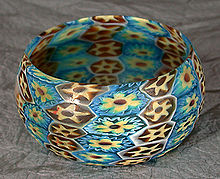Fratelli Toso
The Fratelli Toso ( Toso brothers) are the founders of a glass factory that is still producing today on the island of Murano near Venice .
history
In 1854 Pietro Toso's 6 sons (Ferdinando, Carlo, Liberato, Angelo, Giovanni and Gregorio) founded a small glassmaking company . Two generations after the fall of the Republic of Venice in 1797 and foreign rule by the Napoleonic troops, this initiative fell out of line because glass production , which had a centuries-old tradition on Murano, was ruined by the political upheavals. Much know-how was lost during the war and the occupation. At first the brothers only made utility and pharmacy jars.
It was Abbot Vincenzo Zanetti who sat down regularly with the brothers after work and instructed them in the traditional techniques of glass art as they existed before 1800. Their first work under this aegis was a large ceiling chandelier in 1864, which the brothers made for the glass museum Museo del Vetro on the island. He can still be seen there today. Other traditional candlesticks of this type followed, which received international attention in two exhibitions in Vienna in 1865 and 1869. The brothers quickly became known, and in the following years they received awards for their objects at a number of other exhibitions in Venice, Paris, Milan, Treviso, Trento and the Vatican.
At the end of the 19th century, when the founders died, the family business had grown to the size of a medium-sized company with around 30 employees and had a branch in Venice on the Rialto Bridge . This resulted in the Antica Vetreria Fratelli Toso in 1901. Lorenzo and Nicolo Toso were the managing directors of this second generation.
The First World War constitutes a turning point; temporarily the production had to be outsourced to Livorno . After the war, the manufactory returned to its parent company and grew to 90 employees.
The third generation after 1936 under Ermanno, Michele and Aldo Toso established global trade relationships and expanded business with American customers in particular.
The company organized an exhibition every year and was regularly represented at the Biennale until 1972.
The fourth generation led the company into a split through family disputes. Ermanno's sons (who died in 1973) withdrew from the business. Arnoldo, the son of Michele, who died in 1946, got involved in insoluble conflicts with his uncle Aldo, who had replaced Michele in the year he died. The company "Fratelli Toso 1854 International", which was spun off by Aldo in 1981, had to close in 1982, while Arnoldo's "Antica Vetreria Fratelli Toso", which wants to see itself as the legitimate successor to the family business, is still in production.
The art of Fratelli Toso
While the Antica Vetreria had specialized in traditional candlesticks before 1900, which can still be acquired in reconstructions, glass collectors mainly associate this name with dainty vases, small jugs and bowls with colorful rolled-in murrines in the millefiori decor, which are still numerous today Auctions and antique shops. The technique, which was already known in the first century BC in the Roman glass production, consists of cutting small slices (so-called "tessera") from a colored glass strand and melting them in colorless glass.
The Fratelli Toso used 1500 different forms of murrines, which were divided into different categories (Cattedrale, Farfalle, Kiku, Millepiedi, Millepunti, Pavone, Spicchi, Stellati); they can be freely combined with one another and lead to a large number of individually non-repeatable decors.
Early pieces of this type with mostly acid-matt surfaces date from between 1900 and 1920. The variations around 1960 based on designs by Ermanno and Rosanna Tosi do not differ significantly from the technology; however, the shapes are more varied and the colors brighter. The exact dating is difficult for the layman; Catalogs help identify comparison pieces.
After 1950, shimmering shells in the shape of seashells and stars, more rarely in the shape of animals, were designed, which only occasionally show the millefiori decor made with the help of murrines.
literature
- Leslie Pina: Fratelli Toso. Italian Glass 1854-1980 . Schiffer Publishing Ltd., 2004, ISBN 0-7643-2026-2


